Puerto Rico was discovered by the Spaniards (the local Arawaks, called Tainos already knew where it was located) on Nov. 19, 1493, during Columbus’ second voyage. For the next 400 years, it was a Colony of Spain, with two brief interruptions, but with no formal transfer of ‘ownership’.
On July 25, 1898 it was invaded in an expansion to the Hispano-American War that was a bit of a sideshow to the more visible (already decided) Naval Engagements in Manila, Philippines and Santiago, Cuba. In fact, the quick ending action at San Juan Hill near Santiago, apparently allowed spare troops to be available for the Puerto Rico invasion. As a result, Puerto Rico (plus Guam and the Philippines) were transferred to the US as war booty. Both July 25th and Nov. 19th are notable dates for ‘Boricuas’ (as we natives of PR are called) everywhere.
While a Colony, Puerto Rico was seen as a producer of Cane and Coffee, not as a technical development center. Public schools were all but non-existent, and a University had to wait until the Americans showed up, 1903. My Alma Mater, the University of Puerto Rico at Mayagüez, is a Land-Grant school founded in 1911.
Nevertheless, the patent activity with (at the time) a foreign power (the USA) is surprising in the latter parts of the 19th century. Let’s look at the patents issued by the USPTO to Puerto Rico residents within the period.
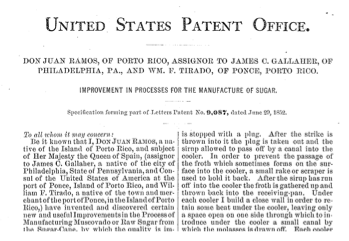 Improvement in Processes for the Manufacture of Sugar
Improvement in Processes for the Manufacture of Sugar
U.S. Patent No. 9,087
Issued June 29, 1852
The first Puerto Rican to receive a US Patent was Juan Ramos, from Ponce, who while a subject of Spain’s Queen Isabella, patented an improved sugarcane juice process (the juice is called ‘Guarapo’) and assigned it to James Gallagher (from Philly) and William Tirado. As seen in the specification and the claims, Don Juan (as we refer to older gentlemen) figured that adding plantain-stalk juice and quicklime helped in defecating the solids within sugar cane juice when making sugar.
Those who know PR reading this will appreciate that when referring to a ‘Boricua’, the term ‘mancha de plátano’ (plantain juice stain) is sometimes used, referring to the staining properties to clothing of said plantain-stalk juice. Serendipity…
Present day practitioners will view with envy a patent application that was witnessed on May 6th, 1852 (and then transported to the USPTO via a sailing ship) that issued on June 29th of the same year!
Improvement for Clarifying Cane-Juice
U.S. Patent No. 26,573
Issued December 27, 1859
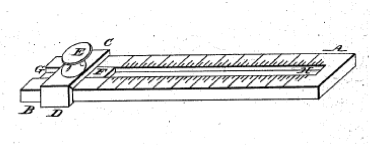 Seven years after Ramos comes Francisco Domenech, another “Ponceño”, with another sugar cane juice processing invention. Perhaps Ramos’ boasted one time too many at the ‘Casino de Ponce’? (The Social Institution at the time in Ponce), which led Francisco to file his? Francisco improved the process by obviating the plantain juice, an early demo of the patent process successive improvements (One hopes making Jefferson and Franklin’s spirits smile?). There is no history of prosecution.
Seven years after Ramos comes Francisco Domenech, another “Ponceño”, with another sugar cane juice processing invention. Perhaps Ramos’ boasted one time too many at the ‘Casino de Ponce’? (The Social Institution at the time in Ponce), which led Francisco to file his? Francisco improved the process by obviating the plantain juice, an early demo of the patent process successive improvements (One hopes making Jefferson and Franklin’s spirits smile?). There is no history of prosecution.
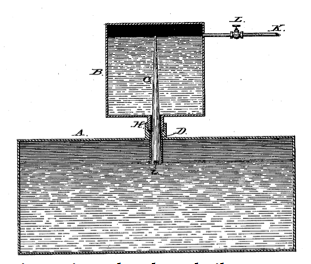 Boiler-Feeder
Boiler-Feeder
U.S. Patent No. 285,585
Issued September 25, 1883
Continuing the “Ponceño” domination, Eliseo del Valle obtained the ‘585 patent for a Boiler-feeder he filed in January 15 and received September 25! (And yet, I bet he complained of slowness on the part of the USPTO and/or of the examiner!).
In those days, steam was the power source for irrigation of sugarcane, making an invention related to a boiler a must have for the sugarcane ‘ingenio’ (Plant).
For those not familiar with PR, we must note that Ponce is the perennial ‘second city’, so this early domination of Patents in PR could only be compared with Chicago outstripping NYC in number of issued patents.
Cover for Culinary and other Receptacles
U.S. Patent No. 291,022
January 1, 1884
Joseph Beaupied, a citizen of France (and NOT a resident of Ponce, he lived in San Juan!!!) patented the cover.
Interestingly, he filed in June 1883 and received the patent the next January.
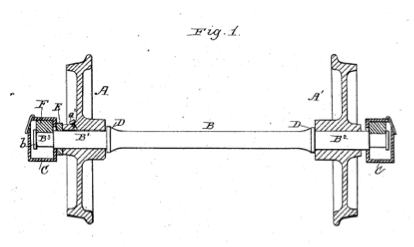 Car Wheel and Axle
Car Wheel and Axle
U.S. Patent No. 291,274
January 1, 1884
And Messr. Beaupied became the first resident of PR to receive two patents on the same day, following ‘022 with ‘274 for a railroad car axle. Interestingly, there was no steam railroad in PR until 1891, so it’s safe to assume Beaupied’s train insight was learned somewhere else. Notably, this application preceded ‘022, taking almost a year to issue.
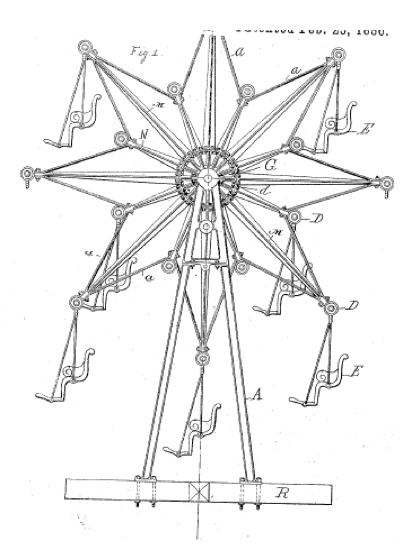 Vertical Rotary Swing
Vertical Rotary Swing
U.S. Patent No. 336,696
February 23, 1886
Lucas Campi, a resident of PR and Citizen of Spain at the time residing in NYC received his Rotary swing, having filed application 173,041 nine months before in July 1895.
While the idea of the ‘Bulgarian Eye’ goes back to 1620, it is interesting to see that Don Lucas predates Ferris by seven years (Columbine Exposition, Chicago).
Feed Pipe for Vacuum Pans
U.S. Patent No. 478,906
Issued July 12, 1892
Forty years after Ramos, with PR still under Spanish control, yet another “Ponceño”, Henry Basanta received a patent for another sugar related invention, a feed pipe for vacuum pans used to crystallized the boiling sugar syrup into sugar crystals.
The application was filed on Sept. 25, 1890, so processing time was similar to modern times. But note that patent 478,906 was application number 368, 083!
 Self Recording Planograph
Self Recording Planograph
U.S. Patent No. 481,432
Issued August 23, 1892
Justo Soler delves into surveying functions with his planograph, although sadly it looks like he died between filing the patent application June 25, 1891 and receiving it a bit over a year later. As before, patent 481,432 comes from application 397,475.
Don Justo was from Yauco (spelled Yanco in the application), a town that would become ‘notorious’ six years later as the place where the invading US troops first encountered organized resistance while moving from the Guánica landing beach towards Ponce.
 Drier
Drier
U.S. Patent No. 544,570
Issued August 13, 1895
Emilio Cabrero from Las Marias received patent ‘570 for a drier suited for drying coffee beans (Las Marias being ‘up the hill’ on the western side of the island, and one of the prime coffee growing areas). Ah, the 1890’s, claim 1 reads;
A drier, comprising a revoluble cylinder having closed ends, a series of communicating circumferential compartments with perforated inner and outer walls, and a heater arranged within the cylinder, substantially as described.
And yes, Don Emilio waited 11 months, but had application number 522,159. (Somewhere along the line some divisions/continuations must have made the number of patents issued larger than the number of applications!).
Conclusion
Well, that closes the 19th century of PR inventions, maybe in a future note we can look at the changes after the ‘handover’ to the US in 1898, and also see some females inventors involved in this business of ours!!!
BTW, we Boricuas were made US citizens in 1917. I keep on hearing about first generation Puertorican-American immigrants, from Sonia Sotomayor to Sonia Manzano (aka Maria from Sesame Street). Those of us born in PR and living in any of the 50 states are no more immigrants to the US than my friend Steve who was born in Florida and lives in NH.
While my practice is based in Nashua, I have a number of clients in PR, whom I try to visit regularly, although no, not as much in the winter as you might think. You don’t get brownie points at home when you’re in PR and a foot of snow falls on Nashua!

![[IPWatchdog Logo]](https://ipwatchdog.com/wp-content/themes/IPWatchdog%20-%202023/assets/images/temp/logo-small@2x.png)

![[Advertisement]](https://ipwatchdog.com/wp-content/uploads/2024/04/Artificial-Intelligence-2024-REPLAY-sidebar-700x500-corrected.jpg)
![[Advertisement]](https://ipwatchdog.com/wp-content/uploads/2024/04/Patent-Litigation-Masters-2024-sidebar-700x500-1.jpg)

![[Advertisement]](https://ipwatchdog.com/wp-content/uploads/2021/12/WEBINAR-336-x-280-px.png)
![[Advertisement]](https://ipwatchdog.com/wp-content/uploads/2021/12/2021-Patent-Practice-on-Demand-recorded-Feb-2021-336-x-280.jpg)
![[Advertisement]](https://ipwatchdog.com/wp-content/uploads/2021/12/Ad-4-The-Invent-Patent-System™.png)






Join the Discussion
5 comments so far.
Luis Figarella
November 24, 2015 03:05 pmGracias Efrain, you are correct on both. I had recently (last week) found 9,086, but since it went to Don Juan Ramos on the same day (June 29) as 9,087, we’ll consider his fortune doubled. Great find on 9,560.
I’d also like to point out to Mr. Martyn that the numbers I have are 516 elementary schools, and 26 secondary schools, a minority of which were public, the great majority ‘Colegios’ for the elites (A tradition of ‘Colegios’ that is a sad and FIRM Spanish tradition from the Rio Grande to Ushuaia). Iliteracy was 80% and sadly 16% of school aged children attended school. (http://www.puertadetierra.info/educacion1.asp)
And congrats to the Pharmacist. We engineers still had to wait until 1911. Mind you, Spain was able to found the following Universities; Santo Domingo 1538, Lima 1551, Mexico City 1551, La Paz 1552, Santiago RD 1558, Bogota 1580, Quito 1580, Lima II 1608, Cordoba (AR) 1613, Santiago (CL) 1619, etc., etc., etc., as I ask the spanish, the check for Puerto Rico’s university got delayed? 🙂
Hence I stand by the statement, “Public schools were all but non-existent…”, no need to rewrite history, lets write the history of a better future.
Luis
Franklyn Irizarry
November 24, 2015 10:39 amAs the patent librarian at your Alma Mater, the University of Puerto Rico at Mayagüez, I congratulate you on your most informative article about XIX Century patents issued to Puerto Rico residents. Since 1996, when USPTO certified our Patent & Trademark Resource Center—PTRC (formerly Patent & Trademark Depository Library—PTDL), we have had a permanent exhibition of such patents at our facility. Your article revealed a gap in our collection of three of those patents which we were not aware of. Thanks to you, we are now able to complete our collection.
On the other hand, your article does not mention the earliest known patent issued to a Puerto Rico resident which is patent number 9,086. Another patents belonging to this period (1850-1898) were also not mentioned.
• Pat. No. 9,086, issued on 06/29/1852, to Juan Ramos and assigned to James C. Gallaher of Philadelphia (at the time U.S. consul at Ponce) and William F. Tirado (a Ponce native and merchant), for an improvement in sugar boiling apparatus.
• Pat. No. 9,560, issued on 01/25/1853, to Josiah W. Archbald of Puerto Rico (town is missing) for an improvement in sugar-draining machines (centrifugal sugar-machine).
Finally, I want to commend you on clarifying a widely held misinformation being portrayed in the national media as well as other circles about us American citizens of Puerto Rico as immigrants. By definition you cannot immigrate into your own country. That is absurd. However, you may migrate from one state or territory (as in the case of Puerto Rico) to another as millions of fellow citizens have been doing for centuries.
Rcm
November 20, 2015 01:16 amThank you for the info. However i must correct you. Under spain we has over 500 schools on the island plus a college of pharmacy and chemistry.
Richard H Le Sesne
November 20, 2015 12:56 amInteresting article. I wonder if that level of activity continues to this day. Although I live in the states, I am a native born Puerto Rican granted six patents and one published application.
ichard martyn
November 20, 2015 12:41 amMr figarella thanks for the info.
O must clarify that when the americans invaded there were over 509 public and private schools in pr
Including a college of pharmacy and chemistry.